7303AFE Economics Assignment: Protectionism and Its Global Impacts
VerifiedAdded on 2022/10/10
|6
|1334
|482
Report
AI Summary
This report provides an in-depth analysis of protectionism, focusing on the imposition of tariffs by the US government in 2018, particularly on steel and aluminum imports, and the subsequent trade war with China. It explores the justifications for protectionist measures, including the protection of fledgling industries and the use of anti-dumping duties, while also examining the effects of trade wars on various countries' GDP and global trade. The report highlights the retaliatory measures taken by China and other nations, such as the imposition of tariffs on US exports, and discusses the adverse impacts on producers, consumers, and the overall global economy. The report also includes a discussion on the effects of trade wars with the US, China and other nations, and the overall impact on international industries. The analysis draws upon economic theories and concepts to evaluate the consequences of protectionist policies and their implications for international trade and economic growth.
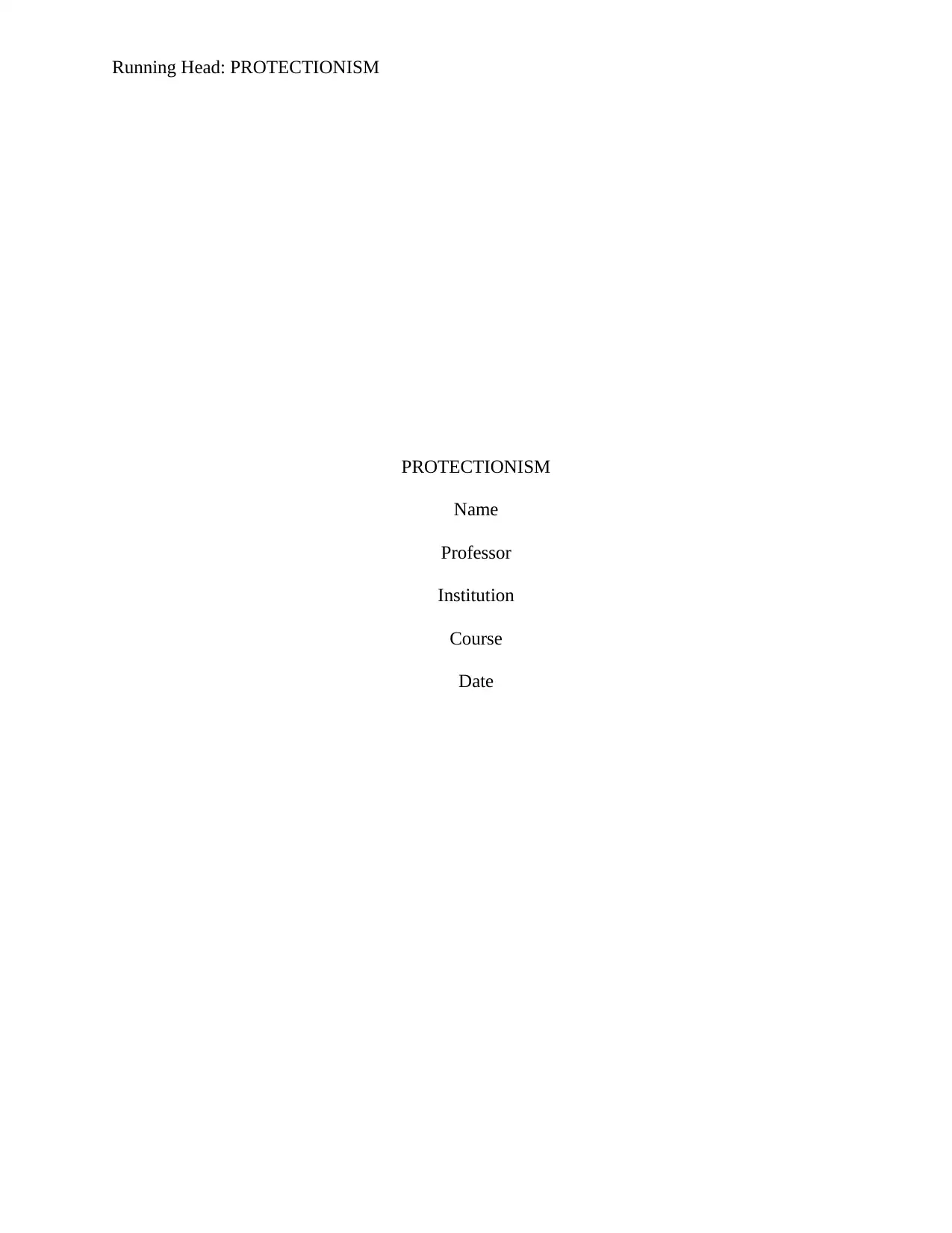
Running Head: PROTECTIONISM
PROTECTIONISM
Name
Professor
Institution
Course
Date
PROTECTIONISM
Name
Professor
Institution
Course
Date
Paraphrase This Document
Need a fresh take? Get an instant paraphrase of this document with our AI Paraphraser
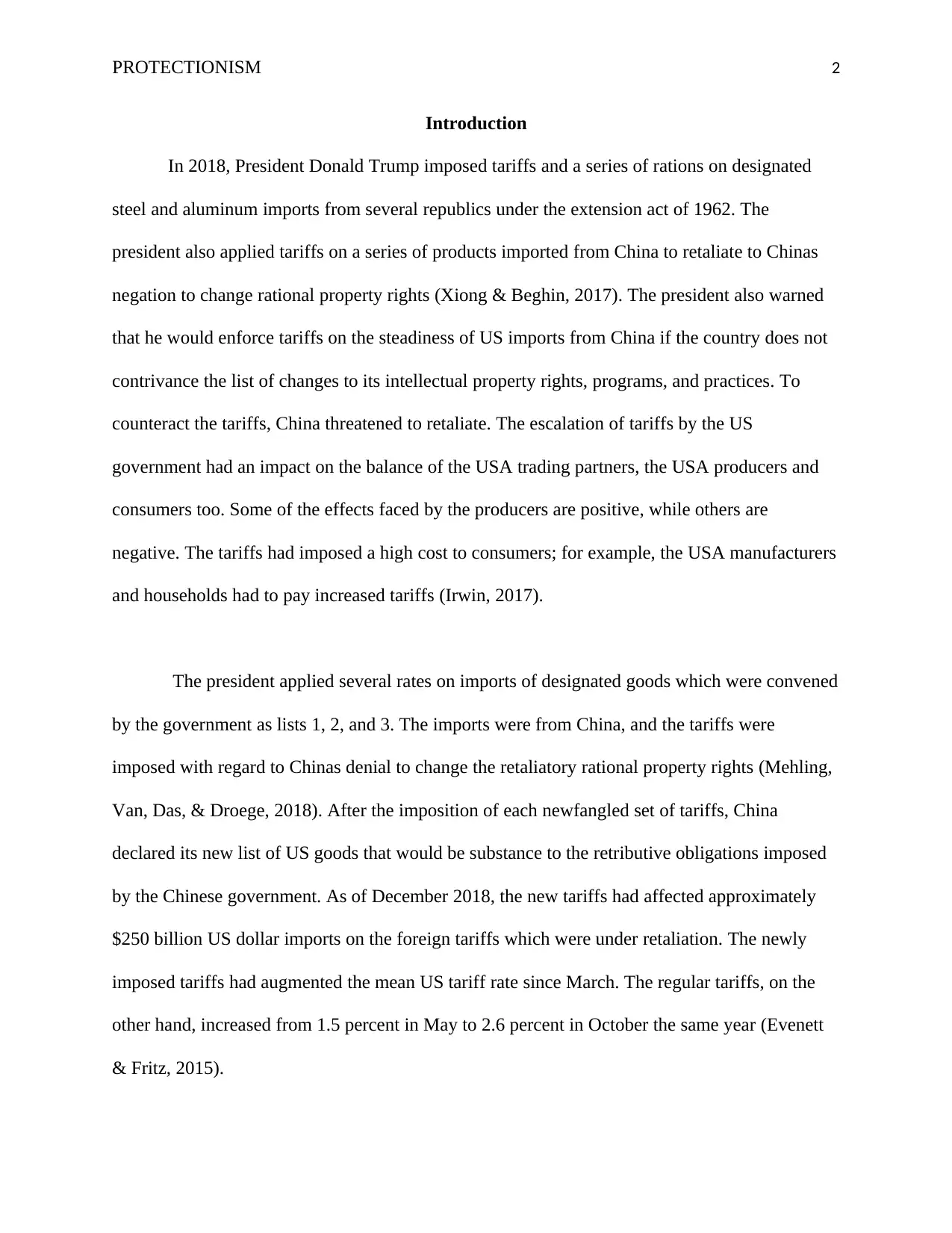
PROTECTIONISM 2
Introduction
In 2018, President Donald Trump imposed tariffs and a series of rations on designated
steel and aluminum imports from several republics under the extension act of 1962. The
president also applied tariffs on a series of products imported from China to retaliate to Chinas
negation to change rational property rights (Xiong & Beghin, 2017). The president also warned
that he would enforce tariffs on the steadiness of US imports from China if the country does not
contrivance the list of changes to its intellectual property rights, programs, and practices. To
counteract the tariffs, China threatened to retaliate. The escalation of tariffs by the US
government had an impact on the balance of the USA trading partners, the USA producers and
consumers too. Some of the effects faced by the producers are positive, while others are
negative. The tariffs had imposed a high cost to consumers; for example, the USA manufacturers
and households had to pay increased tariffs (Irwin, 2017).
The president applied several rates on imports of designated goods which were convened
by the government as lists 1, 2, and 3. The imports were from China, and the tariffs were
imposed with regard to Chinas denial to change the retaliatory rational property rights (Mehling,
Van, Das, & Droege, 2018). After the imposition of each newfangled set of tariffs, China
declared its new list of US goods that would be substance to the retributive obligations imposed
by the Chinese government. As of December 2018, the new tariffs had affected approximately
$250 billion US dollar imports on the foreign tariffs which were under retaliation. The newly
imposed tariffs had augmented the mean US tariff rate since March. The regular tariffs, on the
other hand, increased from 1.5 percent in May to 2.6 percent in October the same year (Evenett
& Fritz, 2015).
Introduction
In 2018, President Donald Trump imposed tariffs and a series of rations on designated
steel and aluminum imports from several republics under the extension act of 1962. The
president also applied tariffs on a series of products imported from China to retaliate to Chinas
negation to change rational property rights (Xiong & Beghin, 2017). The president also warned
that he would enforce tariffs on the steadiness of US imports from China if the country does not
contrivance the list of changes to its intellectual property rights, programs, and practices. To
counteract the tariffs, China threatened to retaliate. The escalation of tariffs by the US
government had an impact on the balance of the USA trading partners, the USA producers and
consumers too. Some of the effects faced by the producers are positive, while others are
negative. The tariffs had imposed a high cost to consumers; for example, the USA manufacturers
and households had to pay increased tariffs (Irwin, 2017).
The president applied several rates on imports of designated goods which were convened
by the government as lists 1, 2, and 3. The imports were from China, and the tariffs were
imposed with regard to Chinas denial to change the retaliatory rational property rights (Mehling,
Van, Das, & Droege, 2018). After the imposition of each newfangled set of tariffs, China
declared its new list of US goods that would be substance to the retributive obligations imposed
by the Chinese government. As of December 2018, the new tariffs had affected approximately
$250 billion US dollar imports on the foreign tariffs which were under retaliation. The newly
imposed tariffs had augmented the mean US tariff rate since March. The regular tariffs, on the
other hand, increased from 1.5 percent in May to 2.6 percent in October the same year (Evenett
& Fritz, 2015).
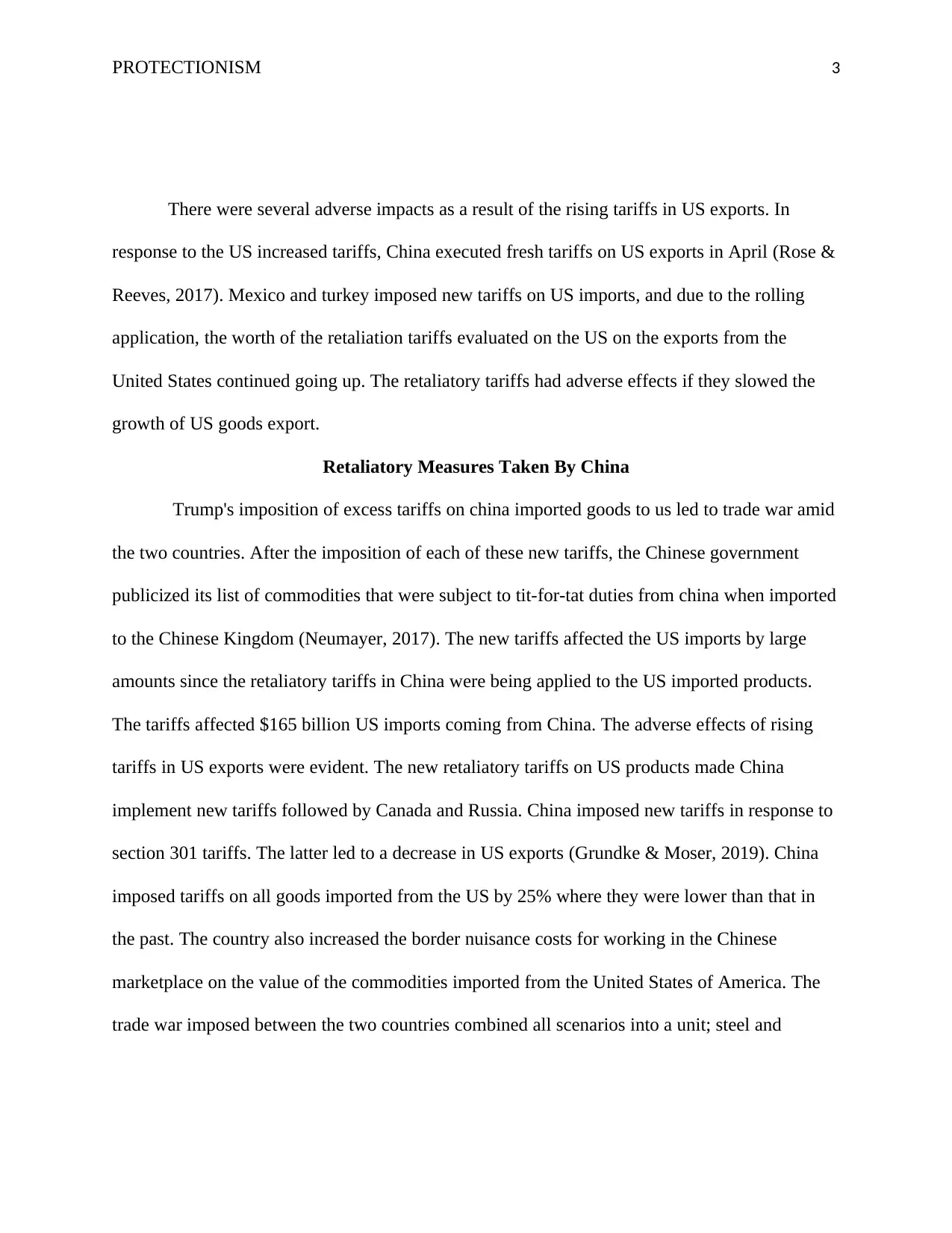
PROTECTIONISM 3
There were several adverse impacts as a result of the rising tariffs in US exports. In
response to the US increased tariffs, China executed fresh tariffs on US exports in April (Rose &
Reeves, 2017). Mexico and turkey imposed new tariffs on US imports, and due to the rolling
application, the worth of the retaliation tariffs evaluated on the US on the exports from the
United States continued going up. The retaliatory tariffs had adverse effects if they slowed the
growth of US goods export.
Retaliatory Measures Taken By China
Trump's imposition of excess tariffs on china imported goods to us led to trade war amid
the two countries. After the imposition of each of these new tariffs, the Chinese government
publicized its list of commodities that were subject to tit-for-tat duties from china when imported
to the Chinese Kingdom (Neumayer, 2017). The new tariffs affected the US imports by large
amounts since the retaliatory tariffs in China were being applied to the US imported products.
The tariffs affected $165 billion US imports coming from China. The adverse effects of rising
tariffs in US exports were evident. The new retaliatory tariffs on US products made China
implement new tariffs followed by Canada and Russia. China imposed new tariffs in response to
section 301 tariffs. The latter led to a decrease in US exports (Grundke & Moser, 2019). China
imposed tariffs on all goods imported from the US by 25% where they were lower than that in
the past. The country also increased the border nuisance costs for working in the Chinese
marketplace on the value of the commodities imported from the United States of America. The
trade war imposed between the two countries combined all scenarios into a unit; steel and
There were several adverse impacts as a result of the rising tariffs in US exports. In
response to the US increased tariffs, China executed fresh tariffs on US exports in April (Rose &
Reeves, 2017). Mexico and turkey imposed new tariffs on US imports, and due to the rolling
application, the worth of the retaliation tariffs evaluated on the US on the exports from the
United States continued going up. The retaliatory tariffs had adverse effects if they slowed the
growth of US goods export.
Retaliatory Measures Taken By China
Trump's imposition of excess tariffs on china imported goods to us led to trade war amid
the two countries. After the imposition of each of these new tariffs, the Chinese government
publicized its list of commodities that were subject to tit-for-tat duties from china when imported
to the Chinese Kingdom (Neumayer, 2017). The new tariffs affected the US imports by large
amounts since the retaliatory tariffs in China were being applied to the US imported products.
The tariffs affected $165 billion US imports coming from China. The adverse effects of rising
tariffs in US exports were evident. The new retaliatory tariffs on US products made China
implement new tariffs followed by Canada and Russia. China imposed new tariffs in response to
section 301 tariffs. The latter led to a decrease in US exports (Grundke & Moser, 2019). China
imposed tariffs on all goods imported from the US by 25% where they were lower than that in
the past. The country also increased the border nuisance costs for working in the Chinese
marketplace on the value of the commodities imported from the United States of America. The
trade war imposed between the two countries combined all scenarios into a unit; steel and
⊘ This is a preview!⊘
Do you want full access?
Subscribe today to unlock all pages.

Trusted by 1+ million students worldwide
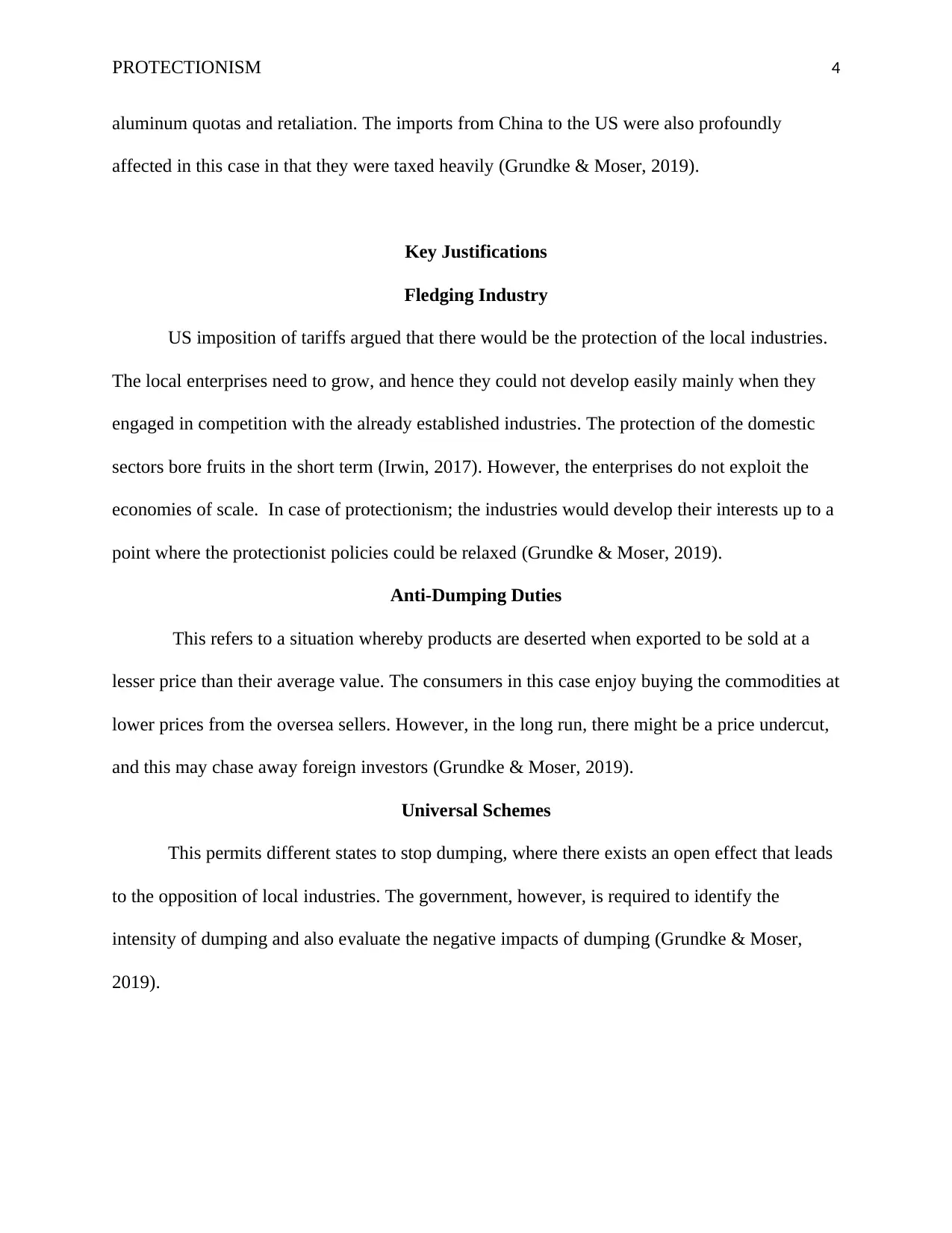
PROTECTIONISM 4
aluminum quotas and retaliation. The imports from China to the US were also profoundly
affected in this case in that they were taxed heavily (Grundke & Moser, 2019).
Key Justifications
Fledging Industry
US imposition of tariffs argued that there would be the protection of the local industries.
The local enterprises need to grow, and hence they could not develop easily mainly when they
engaged in competition with the already established industries. The protection of the domestic
sectors bore fruits in the short term (Irwin, 2017). However, the enterprises do not exploit the
economies of scale. In case of protectionism; the industries would develop their interests up to a
point where the protectionist policies could be relaxed (Grundke & Moser, 2019).
Anti-Dumping Duties
This refers to a situation whereby products are deserted when exported to be sold at a
lesser price than their average value. The consumers in this case enjoy buying the commodities at
lower prices from the oversea sellers. However, in the long run, there might be a price undercut,
and this may chase away foreign investors (Grundke & Moser, 2019).
Universal Schemes
This permits different states to stop dumping, where there exists an open effect that leads
to the opposition of local industries. The government, however, is required to identify the
intensity of dumping and also evaluate the negative impacts of dumping (Grundke & Moser,
2019).
aluminum quotas and retaliation. The imports from China to the US were also profoundly
affected in this case in that they were taxed heavily (Grundke & Moser, 2019).
Key Justifications
Fledging Industry
US imposition of tariffs argued that there would be the protection of the local industries.
The local enterprises need to grow, and hence they could not develop easily mainly when they
engaged in competition with the already established industries. The protection of the domestic
sectors bore fruits in the short term (Irwin, 2017). However, the enterprises do not exploit the
economies of scale. In case of protectionism; the industries would develop their interests up to a
point where the protectionist policies could be relaxed (Grundke & Moser, 2019).
Anti-Dumping Duties
This refers to a situation whereby products are deserted when exported to be sold at a
lesser price than their average value. The consumers in this case enjoy buying the commodities at
lower prices from the oversea sellers. However, in the long run, there might be a price undercut,
and this may chase away foreign investors (Grundke & Moser, 2019).
Universal Schemes
This permits different states to stop dumping, where there exists an open effect that leads
to the opposition of local industries. The government, however, is required to identify the
intensity of dumping and also evaluate the negative impacts of dumping (Grundke & Moser,
2019).
Paraphrase This Document
Need a fresh take? Get an instant paraphrase of this document with our AI Paraphraser

PROTECTIONISM 5
Effects of Trade War
There was no winner in the trade war between the US, China, and the rest of the world.
The countries that were affected by the changes in these tariffs had their GDP affected in several
ways. The other countries were also affected in that they were in low demand for the exports
coming from China and the US. The global trade has been adversely affected by the protectionist
moves since states turn inwards (Mehling, Van, Das, & Droege, 2018). The international
industries would also be able to transfer commodities to the end market so that they can remain
to be competitive in the market. China experienced a substantial decline in its imports as a result
of the increased content of its exports (Mehling, Van, Das, & Droege, 2018).
Effects of Trade War
There was no winner in the trade war between the US, China, and the rest of the world.
The countries that were affected by the changes in these tariffs had their GDP affected in several
ways. The other countries were also affected in that they were in low demand for the exports
coming from China and the US. The global trade has been adversely affected by the protectionist
moves since states turn inwards (Mehling, Van, Das, & Droege, 2018). The international
industries would also be able to transfer commodities to the end market so that they can remain
to be competitive in the market. China experienced a substantial decline in its imports as a result
of the increased content of its exports (Mehling, Van, Das, & Droege, 2018).
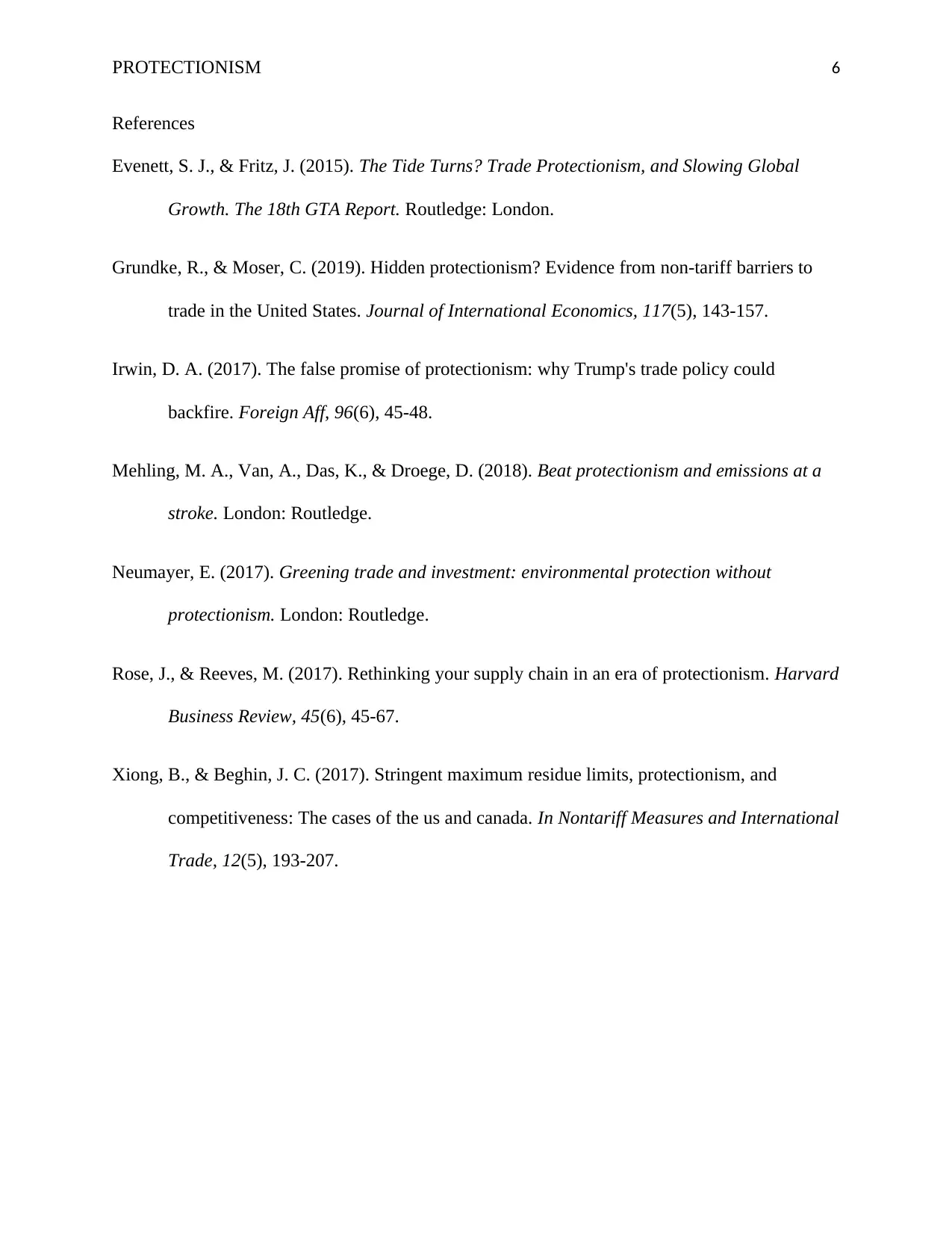
PROTECTIONISM 6
References
Evenett, S. J., & Fritz, J. (2015). The Tide Turns? Trade Protectionism, and Slowing Global
Growth. The 18th GTA Report. Routledge: London.
Grundke, R., & Moser, C. (2019). Hidden protectionism? Evidence from non-tariff barriers to
trade in the United States. Journal of International Economics, 117(5), 143-157.
Irwin, D. A. (2017). The false promise of protectionism: why Trump's trade policy could
backfire. Foreign Aff, 96(6), 45-48.
Mehling, M. A., Van, A., Das, K., & Droege, D. (2018). Beat protectionism and emissions at a
stroke. London: Routledge.
Neumayer, E. (2017). Greening trade and investment: environmental protection without
protectionism. London: Routledge.
Rose, J., & Reeves, M. (2017). Rethinking your supply chain in an era of protectionism. Harvard
Business Review, 45(6), 45-67.
Xiong, B., & Beghin, J. C. (2017). Stringent maximum residue limits, protectionism, and
competitiveness: The cases of the us and canada. In Nontariff Measures and International
Trade, 12(5), 193-207.
References
Evenett, S. J., & Fritz, J. (2015). The Tide Turns? Trade Protectionism, and Slowing Global
Growth. The 18th GTA Report. Routledge: London.
Grundke, R., & Moser, C. (2019). Hidden protectionism? Evidence from non-tariff barriers to
trade in the United States. Journal of International Economics, 117(5), 143-157.
Irwin, D. A. (2017). The false promise of protectionism: why Trump's trade policy could
backfire. Foreign Aff, 96(6), 45-48.
Mehling, M. A., Van, A., Das, K., & Droege, D. (2018). Beat protectionism and emissions at a
stroke. London: Routledge.
Neumayer, E. (2017). Greening trade and investment: environmental protection without
protectionism. London: Routledge.
Rose, J., & Reeves, M. (2017). Rethinking your supply chain in an era of protectionism. Harvard
Business Review, 45(6), 45-67.
Xiong, B., & Beghin, J. C. (2017). Stringent maximum residue limits, protectionism, and
competitiveness: The cases of the us and canada. In Nontariff Measures and International
Trade, 12(5), 193-207.
⊘ This is a preview!⊘
Do you want full access?
Subscribe today to unlock all pages.

Trusted by 1+ million students worldwide
1 out of 6
Related Documents
Your All-in-One AI-Powered Toolkit for Academic Success.
+13062052269
info@desklib.com
Available 24*7 on WhatsApp / Email
![[object Object]](/_next/static/media/star-bottom.7253800d.svg)
Unlock your academic potential
Copyright © 2020–2025 A2Z Services. All Rights Reserved. Developed and managed by ZUCOL.





